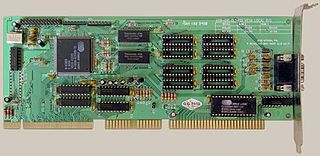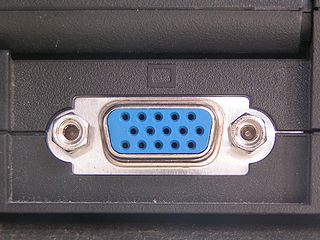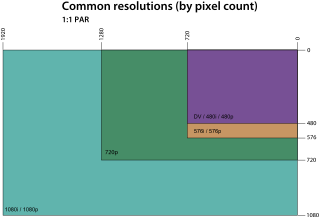Video Graphics Array is a graphics standard for personal computers and associated connectors.
VGA may also refer to:

Digital Visual Interface (DVI) is a video display interface developed by the Digital Display Working Group (DDWG). The digital interface is used to connect a video source, such as a video display controller, to a display device, such as a computer monitor. It was developed with the intention of creating an industry standard for the transfer of uncompressed digital video content.

VESA, formally known as Video Electronics Standards Association, is an American technical standards organization for computer display standards. The organization was incorporated in California in July 1989 and has its office in San Jose. It claims a membership of over 300 companies.

Video Graphics Array (VGA) is a video display controller and accompanying de facto graphics standard, first introduced with the IBM PS/2 line of computers in 1987, which became ubiquitous in the IBM PC compatible industry within three years. The term can now refer to the computer display standard, the 15-pin D-subminiature VGA connector, or the 640×480 resolution characteristic of the VGA hardware.

A graphics card is a computer expansion card that generates a feed of graphics output to a display device such as a monitor. Graphics cards are sometimes called discrete or dedicated graphics cards to emphasize their distinction to integrated graphics processor on the motherboard or the CPU. A graphics processing unit (GPU) that performs the necessary computations is the main component in a graphics card, but the acronym "GPU" is sometimes also used to refer to the graphics card as a whole.

The Enhanced Graphics Adapter (EGA) is an IBM PC graphics adapter and de facto computer display standard from 1984 that superseded the CGA standard introduced with the original IBM PC, and was itself superseded by the VGA standard in 1987. In addition to the original EGA card manufactured by IBM, many compatible third-party cards were manufactured, and EGA graphics modes continued to be supported by VGA and later standards.
The Display Data Channel, or DDC, is a collection of protocols for digital communication between a computer display and a graphics adapter that enable the display to communicate its supported display modes to the adapter and that enable the computer host to adjust monitor parameters, such as brightness and contrast.
Apple Inc. sold a variety of LCD and CRT computer displays in the past. Apple paused production of their own standalone displays in 2016 and partnered with LG to design displays for Macs. In June 2019, the Pro Display XDR was introduced, however it was expensive and targeted for professionals. Nearly three years later, in March 2022, the Studio Display was launched as a consumer-targeted counterpart to the professional monitor. These two are currently the only Apple-branded displays available.

Super VGA (SVGA) is a broad term that covers a wide range of computer display standards that extended IBM's VGA specification.
Enhanced-definition television, or extended-definition television (EDTV) is a Consumer Electronics Association (CEA) marketing shorthand term for certain digital television (DTV) formats and devices. Specifically, this term defines an extension of the standard-definition television (SDTV) format that enables a clearer picture during high-motion scenes compared to previous iterations of SDTV, but not producing images as detailed as high-definition television (HDTV).
The Multi-Color Graphics Array or MCGA is a video subsystem built into the motherboard of the IBM PS/2 Model 30, introduced on April 2, 1987, and Model 25, introduced later on August 11; no standalone MCGA cards were ever made.

The Video Graphics Array (VGA) connector is a standard connector used for computer video output. Originating with the 1987 IBM PS/2 and its VGA graphics system, the 15-pin connector went on to become ubiquitous on PCs, as well as many monitors, projectors and high-definition television sets.

The Monochrome Display Adapter is IBM's standard video display card and computer display standard for the IBM PC introduced in 1981. The MDA does not have any pixel-addressable graphics modes, only a single monochrome text mode which can display 80 columns by 25 lines of high resolution text characters or symbols useful for drawing forms.

Video in video out, commonly pronounced ( VEE-voh), is a graphics port which enables some video cards to have bidirectional analog video transfer through a mini-DIN connector, usually of the 9-pin variety, and a specialised splitter cable.

A video display controller or VDC is an integrated circuit which is the main component in a video-signal generator, a device responsible for the production of a TV video signal in a computing or game system. Some VDCs also generate an audio signal, but that is not their main function.

DMS-59 was generally used for computer video cards. It provides two Digital Visual Interface (DVI) or Video Graphics Array (VGA) outputs in a single connector. A Y-style breakout cable is needed for the transition from the DMS-59 output to DVI (digital) or VGA (analogue), and different types of adapter cables exist. The connector is four pins high and 15 pins wide, with a single pin missing from the bottom row, in a D-shaped shell, with thumbscrews. As of December 2020, this adapter cable was listed as obsolete by its primary vendor Molex.
Serial Digital Video Out (SDVO) is a proprietary Intel technology introduced with their 9xx-series of motherboard chipsets.

The Amiga video connector is a 23-pin male D-subminiature connector fitted to all personal computers in the Amiga range produced by Commodore International from 1985 to 1994, and by Escom from 1995 to 1996. The connector carries signals for analogue and digital RGB, RGB intensity, and genlocking as well as power. Default Amiga screenmodes are directly compatible with TVs in the region in which the computer was sold, so that the user could connect the computer to a common TV if no monitor was available. In the PAL region, the Amiga could be connected directly to the standardized SCART RGB connector on the TV via an adapter cable sold by Commodore, providing superior image quality. Alternatively, Commodore sold an adapter, that attached to the Amiga video connector and provided composite and RF outputs appropriate to the region in which it was sold. Commodore also sold a range of monitors, which were compatible with the TV signals of the region in which they were sold, and in the PAL region many even had SCART inputs so that not only Amigas, but also other SCART-compatible equipment could be attached to them.
DVGA may refer to:

The graphics display resolution is the width and height dimension of an electronic visual display device, measured in pixels. This information is used for electronic devices such as a computer monitor. Certain combinations of width and height are standardized and typically given a name and an initialism that is descriptive of its dimensions. A graphics display resolution can be used in tandem with the size of the graphics display to calculate pixel density. An increase in the pixel density often correlates with a decrease in the size of individual pixels on a display.

AMD Eyefinity is a brand name for AMD video card products that support multi-monitor setups by integrating multiple display controllers on one GPU. AMD Eyefinity was introduced with the Radeon HD 5000 Series "Evergreen" in September 2009 and has been available on APUs and professional-grade graphics cards branded AMD FirePro as well.